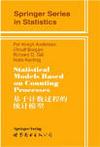基于计数过程的统计模型
1998-8
世界图书出版公司
P.K.Andersen等著
767
无
One of the most remarkable examples of fast technology transfer from new developments in mathematical probability theory to applied statistical methodology is the use of counting processes, martingales in continuous time, and stochastic integration in event history analysis. By this (or generalized survival analysis), we understand the study of a collection of individuals, each moving among a finite (usually small) number of states. A basic example is moving from alive to dead, which forms the basis of survival analysis. Compared to other branches of statistics, this area is characterized by the dynamic temporal aspect, making modelling via the intensities useful, and by the special patterns of incompleteness of observation, of which right-censoring in survival analysis is the most important and best known example.
Preface I. Introduction I.1 General Introduction to the Book 1.2 Brief Survey of the Development of the Subject 1.3 Presentation of Practical Examples II. The Mathematical Background II.1 An Informal Introduction to the Basic Concepts II.2 Preliminaries: Processes, Filtrations, and Stopping Times II.3 Martingale Theory II.4 Counting Processes II.5 Limit Theory II.6 Product-Integration and Markov Processes II.7 Likelihoods and Partial Likelihoods for Counting Processes II.8 The Functional Delta-Method II.9 Bibliographic Remarks III. Model Specification and Censoring III.1 Examples of Counting Process models for Complete Life History Data. The Multiplicative Intensity Model III.2 Right-Censoring III.3 Left-Truncation III.4 General Censorship, Filtering, and Truncation III.5 Partial Model Specifi ation. Time-Dependent Covariates III.6 Bibliographic RemarksIV. Nonparametric Estimation IV.1 The Nelson-Aalen estimator IV.2 Smoothing the Nelson-Aalen Estimator IV.3 The Kaplan-Meier Estimator IV.4 The Product-Limit Estimator for the Transition Matrix of a Nonhomogeneous Markov Process IV.5 Bibliographic RemarksV. Nonparametric Hypothesis Testing V.1 One-Sample Tests V.2 k-Sample Tests V.3 Other Linear Nonparametric Tests V.4 Using the Complete Test Statistic Process V.5 Bibliographic RemarksVI. Parametric Models VI.1 Maximum Likelihood Estimation VI.2 M-Estimators VI.3 Model Checking VI.4 Bibliographic RemarksVII. Regression Models VII.1 Introduction. Regression Model Formulation VII.2 Semiparametric Multiplicative Hazard Models VII.3 Goodness-of-Fit Methods for the Semiparametric Multiplicative Hazard Model VII.4 Nonparametric Additive Hazard Models VII.5 Other Non-and Semi-parametric Regression Models VII.6 Parametric Regression Models VII.7 Bibliographic RemarksVIII. Asymptotic Efficiency VIII.1 Contiguity and'Local Asymptotic Normality VIII.2 Local Asymptotic Normality in Counting Process Models VIII.3 Infinite-dimensional Parameter Spaces: the General Theory VIll.4 Semiparametric Counting Process Models VIII.5 Bibliographic RemarksIX. Frailty Models IX.1 Introduction IX.2 Model Construction IX.3 Likelihoods and Intensities ……X. Multivariate Time ScaleAppendixReferencesAuthor IndexSubject Index

无